

Vol. 41 (Issue 12) Year 2020. Page 27
REDONDO, Marlen I. 1; DUQUE, Cristian C. 2; CASTAÑO, Juan M. 3; RÍOS, Karen 4; TAPASCO, Alejandro 5
Received: 16/01/2020 • Approved: 26/03/2020 • Published 09/04/2020
ABSTRACT: This article approaches the problem of first Employment in the Metropolitan Area Central West, Colombia by answering the following questions: What are the main findings of the School to Work Transition Survey? What is the recent outlook in the youth labor market? What are the dynamics of recent graduates of tertiary education linked to the formal sector of the economy? The research showed the persistent genre gap in favor of the male population. Young higher education graduates have greater chances to complete the transition. |
RESUMEN: Este artículo aborda el problema del primer empleo en el Área Metropolitana del Centro Occidente, Colombia, respondiendo las siguientes preguntas: ¿Cuáles son los principales hallazgos de la Encuesta de transición de la escuela al trabajo? ¿Cuál es la perspectiva reciente en el mercado laboral juvenil? ¿Cuáles son las dinámicas de los recién graduados de educación terciaria vinculados al sector formal de la economía? La investigación mostró la brecha de género persistente a favor de la población masculina. Los jóvenes graduados de educación superior tienen mayores posibilidades de completar la transición. |
The benefits of social policy in Colombia to young people is based on conditional monetary transfers to the short-term consumption encore, rather than on an orientation towards the public supplies needed to expand the opportunities for young people by training in technical, technological and higher education through strategies and programs for labour market inclusion, not only in formal labour, but also in entrepreneurship to achieve adequate access by competition in the labour market.
The policies of First Employment are oriented as they are the key link for the social and productive development of the country, mainly, to the young population from 18 to 28 years, which represents 30% of the population of working age and who have an opportunity it is in terms of productive innovation (DANE, 2018). However, the lack of tools for improving apprenticeship in labour skills to the formal education system and the low educational attainment for young people create barriers when accessing to the labour market and it limits young people’s access to better life conditions (Government of Colombia, 2018). This research focuses on a specific region of Colombia known as the Metropolitan Area Central West (hereinafter MACW), which brings together the municipalities of Pereira, Dosquebradas y La Virginia.
It is estimated that about 23% of young people whose ages range from 14 to 28 are unemployed and not studying or receiving any training at MACW, while the group of young people who manage to access to the labour market face informality comprising 50% of MACW youth, who are exposed to low wages and unfavorable hiring conditions (DANE, 2018).
With this being said, it is important to express that the present article is meant to approach the problem of first employment in the MACW, analyzing how the transition from school to work behaves in order to find the roots of the problem. Also, the article looks forward to understanding the dynamics of the phenomena trough regression models in the light of the labour market of the analyzed population. Finally, it looks for the understanding of government policies regarding the solution of the problems young people experience in the search for a formal job.
The investigation is still the qualitative methodology through the methods of documentary analysis that as stated by Atehortúa & Zwerg (2012):
“Use data extracted from the analysis, revision and interpretation of documents that provide information relevant for the understanding of the phenomenon. For this purpose, documents of any species such as bibliographic sources, hemerographic or archival sources are used; the first is based on the consultation of books, the second on articles or essays from magazines and newspapers, and the third in documents that are located in files such as letters offices, circulars, files”(p.100)
The employment situation of young people in the Metropolitan Area Central West (MACW) from 2008 was conceived as the most difficult crisis in the economic context since the Great Depression, directly influencing decision-making determined by the shock real estate and financial markets, especially in the workplace by inquiring about the expectations of labour market integration of young people transitioning from educational institutions to the first employment. In addition, the accelerated increase in the cost of higher education led families decide to borrow money from educational credit institutions in order to access to a professional career, whilst in other cases, where credit was not made, they limited the possibilities for a percentage of the young population in the educational field as they are struggling to join to the workplace and to access to the market in order to have an income that will probably serve to pay the debt when applying for the credit (Dettling & Hsu, 2017).
In 2015, the main results in the School to Work Transition Survey (ETET) (CEPAL & OIT, 2017) showed the persistent genre gap in favor of the male population, whose probability of completing the transition is 11 percentage points above the female population.
About the 43 percent of the female population were able to be linked properly in the first Employment; the 29 percent of them could not be linked to the labour market since they were established as economically inactive, but mostly, the achievement to enter higher education to see greater chances of better employment. On the other hand, the remaining 28 percent is in the stage of transition as it is considered unemployed population because of their job instability, or they are considered not in employment, education or training (NEET); in some cases, this population is dedicated to household chores.
In regards to the male population, it was recorded a probability of about 28 percent, which is similar to the one experienced by women when continuing their studies by postponing the transition that could be reflected in an unemployment rate of homogeneous for both genders in the long term. In addition, the proportion of young people in unsatisfactory unstable work is 16 percent, 12 percentage points lower than the outcome of women between 2013 and 2015 (DANE, 2018).
The greatest representations were given in young higher education graduates because they were able to complete the transition to the labour market under adequate conditions; they were influenced by middle education, secondary and primary education.
Those young people who did not participate in the propaedeutic cycle have almost nil possibility of completing the transition, whereas in the uninitiated transition stage there can be a wide possibility in regards to the transition from secondary to middle and high education; it is reflecting possible increase in the whole transition in coming periods. It also highlights the importance of implementing the first-employment policy to strengthen the prepared workforce that will allow improvements in the performance of the region’s economy.
Concerning the comparative transition from school to work experienced by men and women that turned out to be similar, there is a completely different trend among minors (14 to 17 years) and young adults (18 to 29 years) among all young people linked to well-paid and stable employment. Only a 6 percent corresponds to children under 14 to 17 years of age; the other 94 percent refers to young adults who have managed to complete their vocational training or simply entered to the labour market by age range required by legal quotations, in the same way, they also managed to establish themselves as formal employees in a large-area company.
Young people are transitioning from 14 to 17 years old, this means they represent only 13 percent of the total and 87 percent of unemployed youth, not in employment, education or training (NEET) or occupied in unstable jobs low-paid expressed have between 18 to 29 years of age for 2013 and/or 2015. In contrast, the majority of young people who have not started their working life (transition not initiated) corresponds to children under 14 to 17 years old in a 65 percent, the remaining 35 percent is representing young adults who decided to continue studying in order to join the labour market of youth in the future (DANE, 2018).
Figure 1
Duration of transition.

Source: DANE (2018) School to Work Transition Survey
Based on the guidelines of the International Labor Organization (ILO) regarding the School to Work Transition Survey, young people who have managed to complete this transition thanks to the appropriate First Employment policies, for instance, they can experience short and long term average to their transition period (CEPAL & OIT, 2017).
Approximately 55 percent of young people experienced a short-term transition to the labour market, achieving in this way a formal link to stable and satisfactory jobs without becoming unemployed or inactive for more than a quarter and they never had informal job with low-paid for more than year(DANE, 2018).
Young people claim to have had an average of 26 percent transition in the labour world as they are always working, though they are exercising unstable unsatisfactory jobs between 12 and 24 months or unemployed less than 12 months (DANE, 2018). On the other hand, 18 percent of young people assured that their transition was long, carrying out unstable or unsatisfactory work for more than 24 months or sought employment without being hired for more than 12 months.
According to Modigliani’s Life Cycle Theory (1988), it is in the youth labour market where most people found their “First Job”. For this reason, it is necessary to study the dynamics of work experienced by young people between 18 and 28 years old of the MACW from the mobile quarter of 2019 based on the statistics offered by the Ministry of Labour through SLIC (Source of Labour Information of Colombia)
The Global Participation Rate (GPR), that measures the labor supply of youth has ranged between 70.4 % and 84.9% since 2010 to 2019 (January-March), it is increasing in the last months of the year in the Christmas season until February – April (see figure 2), when the search for seasonal employment ends. Likewise, the Economically Active Population (EAP) has fluctuated in this same period between 78,932 and 99,562 young people who are seeking employment (unemployed) or they have already found it (employed) in the MACW.
On the other hand, it was observed that the youth GPR has been at least 10 percentage points (p.p.) higher in the MACW than in the 23 total metropolitan areas, and Bogotá D.C between 2010 and 2019 (January- March).
Under those circumstances, there is an indication of a labor supply exceptionally dynamic in the department as the proportion of the young inactive occupationally (who do not have nor seek employment) is generally dedicated to unpaid care economy or to continuing their studies at MACW. Then, the Economically Inactive Population (EIP=22%) has been equivalent at half the national average (41.73%) from 2010 to 2019 (January- March).
Figure 2
The Global Participation Rate and Youth
Inactivity Rate between 2010-1 and 2019-3
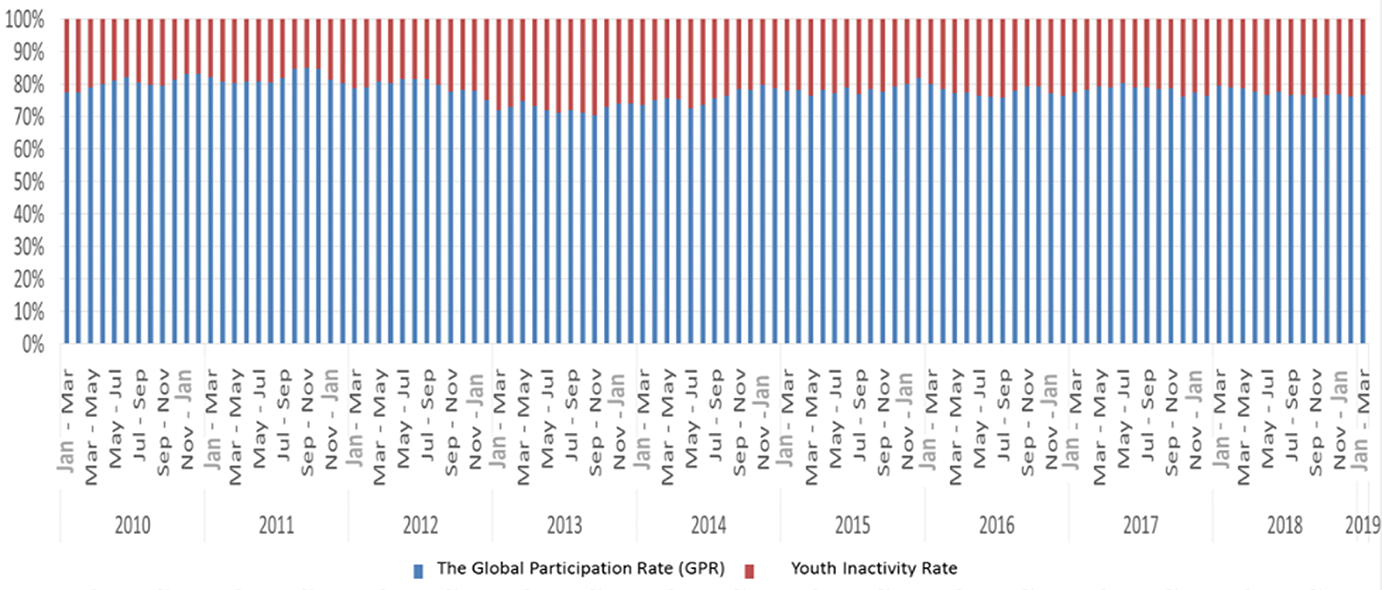
Source: Produced by the authors with DANE’s figures (2019) – Continuous Household Survey
On the other hand, the young labour market demand is estimated on the basis of the Occupation Rate (OR), which has registered a positive trend from a minimum of 51 percent in 2010 (January-March) to values of approximately 65 percent during 2018 (see figure 3), it is being possible to highlight that OR in the MACW (61.13%) it has been an average of 13 p.p. higher than in the rest of the country (48.49%). Likewise, it is observed that the 25% of the new jobs generated (15.566 new jobs) in the MACW have been for young people who would go from occupying 57.935 plazas in 2010 (January-March) to 76.190 in the same period of 2019.
Figure 3
Youth employment, unemployment and labour formality between 2010-1 y 2019-3
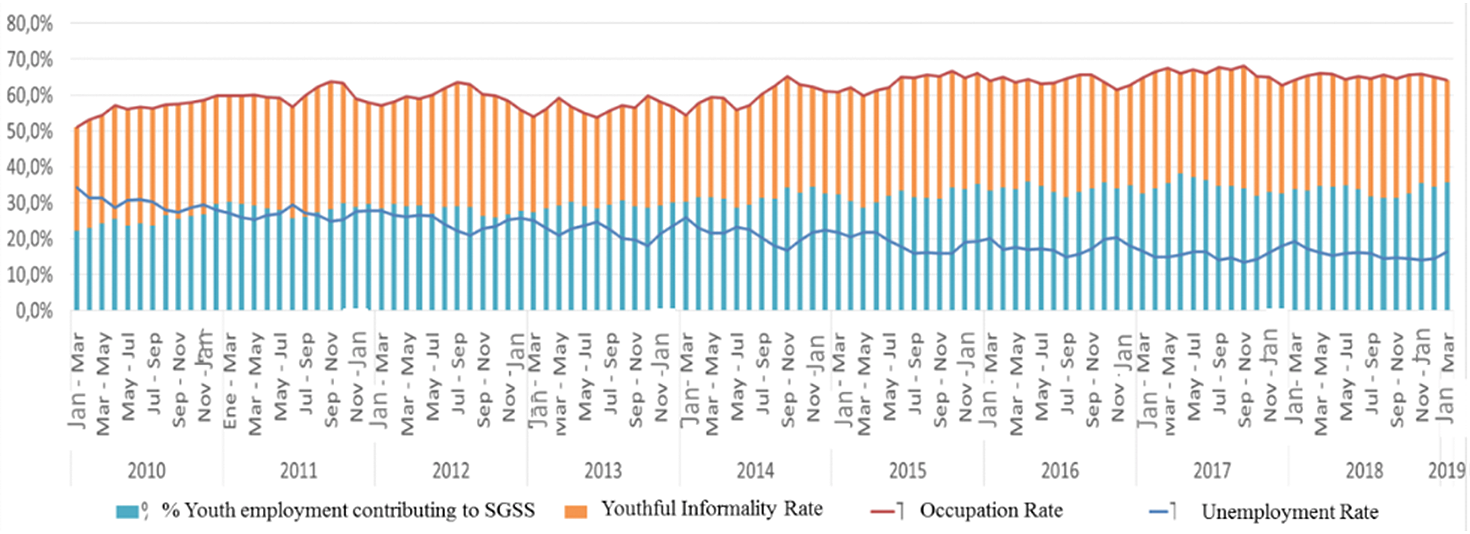
Source: Produced by the authors with DANE’s figures (2019) – Continuous Household Survey
However, the proportion of employed people in their first job was reduced from 18% to 13% between 2010 and 2017 resulted similar to the proportion of employed people that are seeking employment for the first time (applicants), whose participation decreased from 14 percent in 2010 (8.930 applicants) to 9% in 2017 (2.780 applicants); similarly, the average number of young people in current employment decreased from 1.7 to 1.5 (Cámara de Comercio de Pereira, 2018).
In order to generate new First Employment policies and improve existing ones, it is crucial to understand the main obstacles faced by unemployed youth in MACW to find the job they are seeking for.
According to the School to Work Transition Survey prepared by the National Government in synergy with the International Labor Organization (ILO) from 2013 to 2015, the main challenge for unemployed men and women have been the lack of work experience necessary to fulfill the available vacancies (see figure 4 and 5). It is being a pronouncement to policy formulators, the efficient establishment of First Employment programs that provide the opportunity for young people to gain work experience, especially, when they finish the stage of educational transition and become part of the right population to participate in the labour market with efficient competencies and capacities; also, to ensure optimal working conditions when being formally established in the MACY’s labour market.
Figure 4
Unemployed women by main obstacle to finding good employment
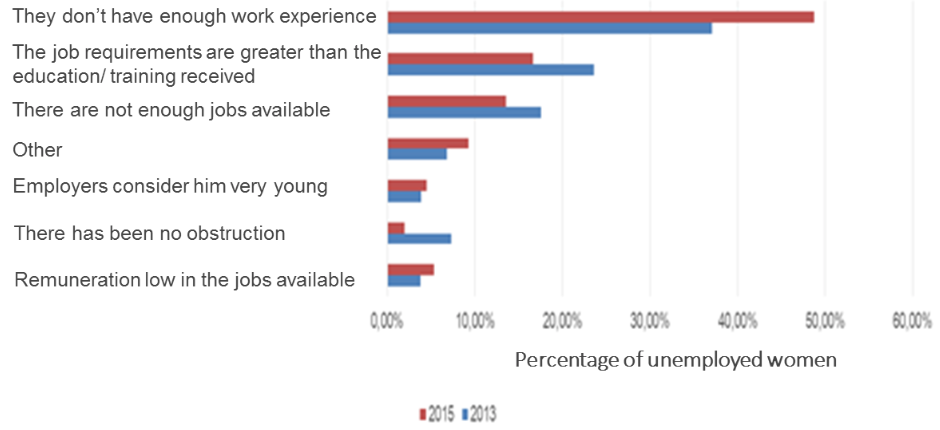
Source: DANE (2018) – School to Work Transition Survey
Figure 5
Unemployed men by main obstacle to finding good employment
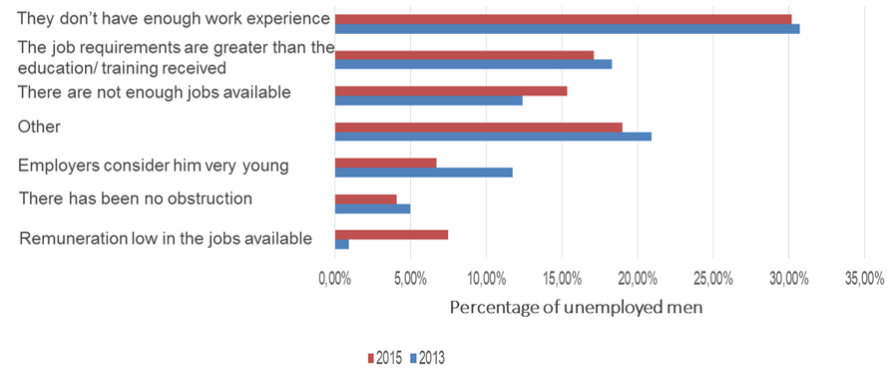
Source: DANE (2018) – School to Work Transition Survey
In the case of men, the figure 5 indicates that the main obstacle is not having enough work experience with a percentage between 28% and 30% from 2013 to 2015, but the low level of training, as it constitutes an obstacle for the 18% of unemployed young people in the MACW followed by the scarce labour demand available with 14%, which is a lower age range than the required by the employer 8%, and the remuneration is low in the vacancies consulted 3%.
Through the collection of data from the department of Risaralda, where the MACW is located, it can be seen in figure 6 that only 2 out of every 11 young people contributed to pension, health and occupational risk from 2009 to 2016 (an average of 42.651 contributors); meanwhile, about 82.13% of the remaining young people (196.046 young people on average) were unemployed, left the country, worked in the informal sector of the economy; some others dedicated to the unpaid care economy or continued with their studies or integrated the Economically Inactive Population (EIP) during the referenced years.
Figure 6
Young people who contribute to SGSS for the total population between 18 and 28 years old
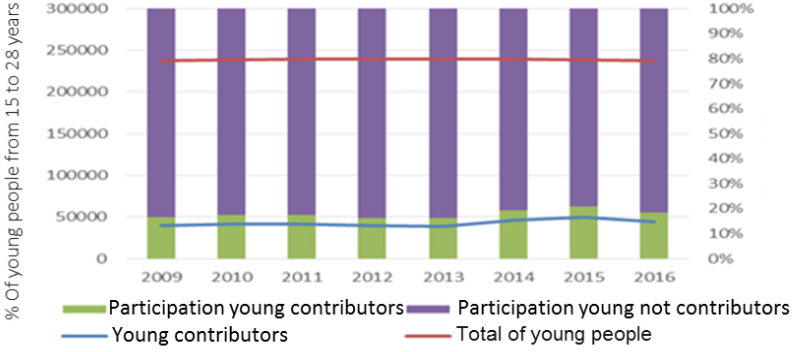
Source: TerriData (2019), FILCO’s data - Ministerio Del Trabajo y DANE (2019)
It is worth mentioning the high informality that exists in the employment of young people as a percentage of the total in the municipalities of MACW (Pereira, Dosquebradas and La Virginia) symptom of a structural deterioration in the youth’s labour market that transcends to the conjuncture of the world economic crisis; despite of the recovery in the economy, fewer young applicants are able to occupy decent employment status. However, in some cases because of the inexperience they are in the area, companies are aimed at offering only operational-level position and many of these young people come out with different occupational profiles.
3.2.5. The General Participation Rate (GPR) in the youth labour market
To identify how the GPR applies to the youth labour market, the model considers that if the GPR (that brings together occupied and unemployed workers) would be 0%, it may be reasonable to conclude that the Unemployment Rate (UR) and the Occupation Rate (OR) are too. However, given the increase in the explanatory potential (↑R2) and the statistical significance (↓α) in the model through origin as for the model that assumes a non-zero intercept, the β1 coefficient that measures the effect of GPR on to (OR) and/or the (UR), also increases significantly by altering its impact on the youth’s labour market by converting the slope into a biased estimator of β1.
Figure 7
Relationship between Unemployment Rate and Youth’s GPR
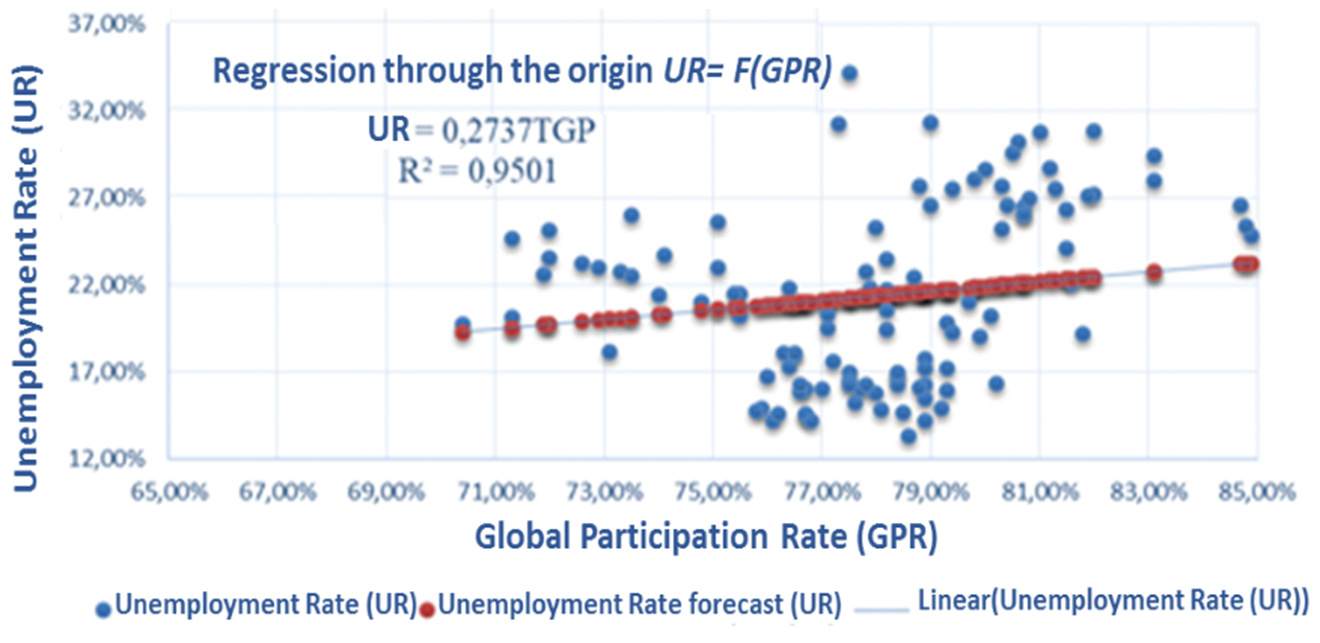
Source: Produced by the authors with FILCO’s figures
The figure 7, presents a direct relationship between Global Participation Rate (GPR) and Youth’s Unemployment Rate (UR) in the MACW of the 2010 mobile quarter (January-March) at the same quarter of 2019, where it is not possible to ensure that 95% of the variations in the Youth’s Unemployment Rate are generated by changes in GPR, since the slope (β1=0, 2737) is a biased estimator towards the observations that oversize the effect of GPR on the UR preventing the proper formulation of predictions in the Youth’s labour market (Wooldridge, 2010).
Thus, it is not possible to affirm that the variations of the Youth’s Unemployment Rate (UR) are proportional to those of the GPR in practice given a unitary elasticity (E=1) inherent to the regressions through the origin. That is to say that although the estimated model of OLS establishes that in the case of a variation 1%, ceteris paribus, the reality lived by the young people of the MACW can be different.
Figure 8
Relationship between Occupation Rate and Youth’s GPR
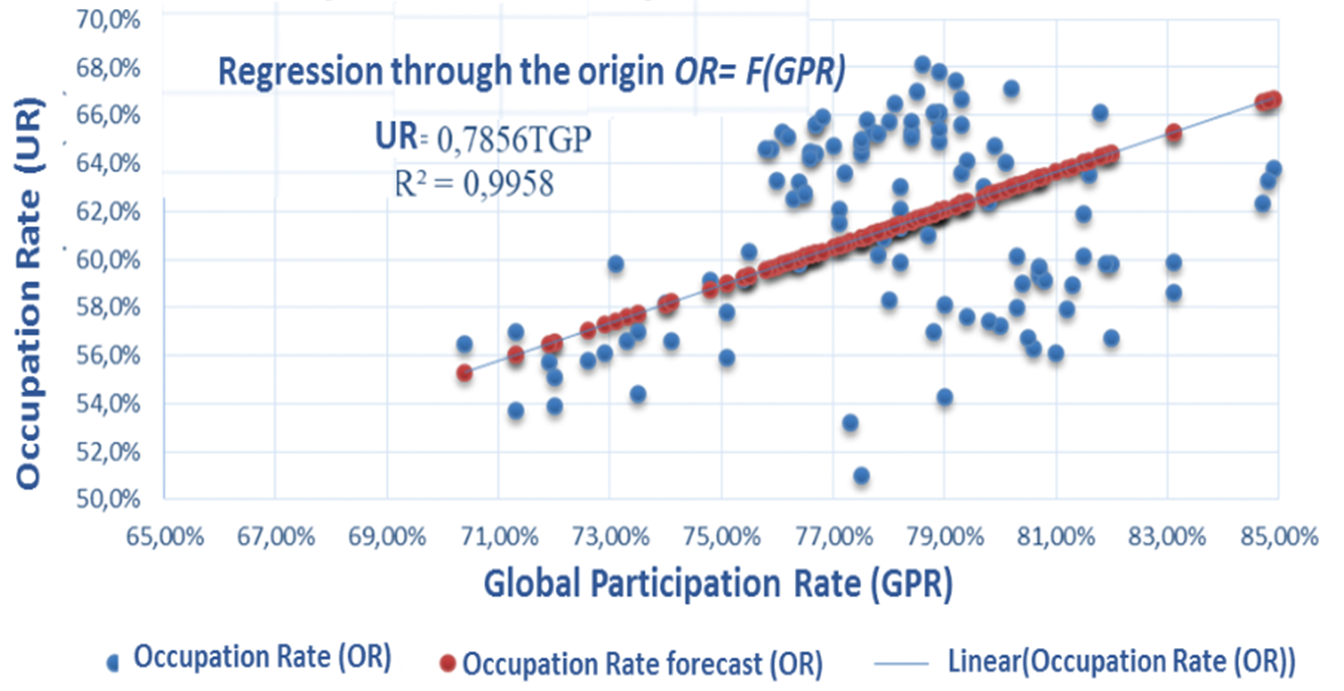
Source: produced by the authors with FILCO’s figures (2019)
In the same way, there is a direct relationship between Global Participation Rate (GPR) and Youth´s Occupation Rate (OR), as it can be seen in figure 8, of the 2010 mobile quarter (January- March) to the same quarter of 2019 at the MACW. Since the intercept estimator was not statistically significant (β0=0), the operation is reiterated by assuming a constant equal to zero that manages to raise both the significance level (p<α) and the explanatory potential (R2) of the GPR with respect to juvenile OR to 99% (see Annex B).
However, such as the slope estimator (β1) registers a bias towards the upper curve of observations at OLS through origin (Wooldridge, 2010) it is impractical to assert that only 0.42% of variations in OR are explained by changes in variables other than GPR, ceteris paribus, inherent in regressions through origin (Wooldridge, 2010), the experience of young people in the MACW labour market may be different.
With a R2=0,3591 it is possible to choose the logarithmic regression of the level-long from (decreasing trend) as the most appropriate to estimate the relationship between GPR and remittances in Risaralda are indicating that GPR will always increase 0,1235 points percent (p.p.) for each additional 1% in the value of remittances with destination to the department is showing a decreasing trend where the change in the GPR by 1 percent of additional remittances decrease according as remittances increase; in the other words, the logarithmic regression: TGP=0,0114+0,1235In (remittances) implies a diminishing return on remittances on the GPR in Risaralda (Wooldridge, 2010, page. 43)
Figure 9
Relationship between GPR and remittances in Risaralda
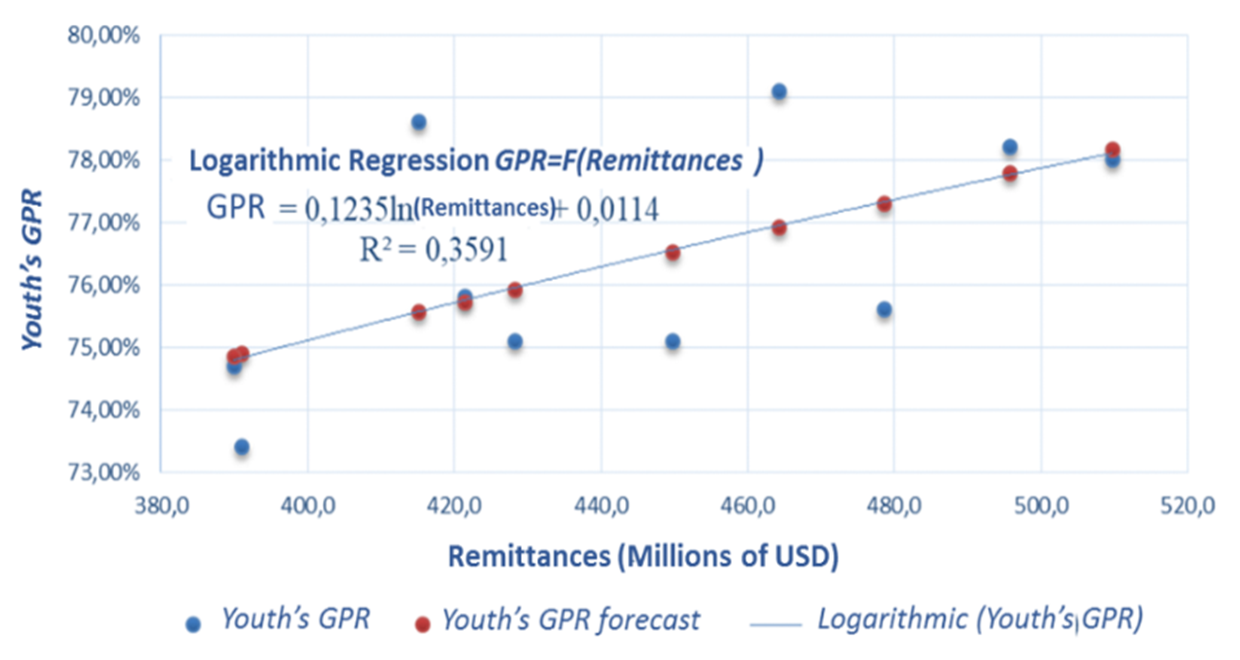
Source: Produced by the authors with Banco de la Republican’s y FILCO figures (2019)
Otherwise, in logarithmic regression seen in figure 9: GPR=0, 0114+0,1235ln (remittances)the intercept value does not have much meaning, because it denotes the predicted GPR when the log(remittances) =zero. Similarly, R2=0, 3591 indicates that the log (remittances), but not the remittances themselves, they manage to explain about 35.91% of the variations in the GPR (Wooldridge, 2010, page. 44).
In contrast, there is an inverse relationship between young people economically inactive (EIP) and remittances in Risaralda from 2010 to 2018 being feasible to define a slight preference for the adjustment of the linear model, whose coefficient of determination (R2=0,3895) it is slightly higher than the logarithmic (R2=0,3881); even if the no regression line fits the figures well enough to make an adequate forecast by attributing only 39% of the variation in EIP around its mean (regression line) to changes in the explanatory variable remittances, and 61% to random forces omitted by the aforementioned model (Gujarati & Porter, 2009).
Figure 10
Relationship between economically inactive youth and remittances in Risaralda
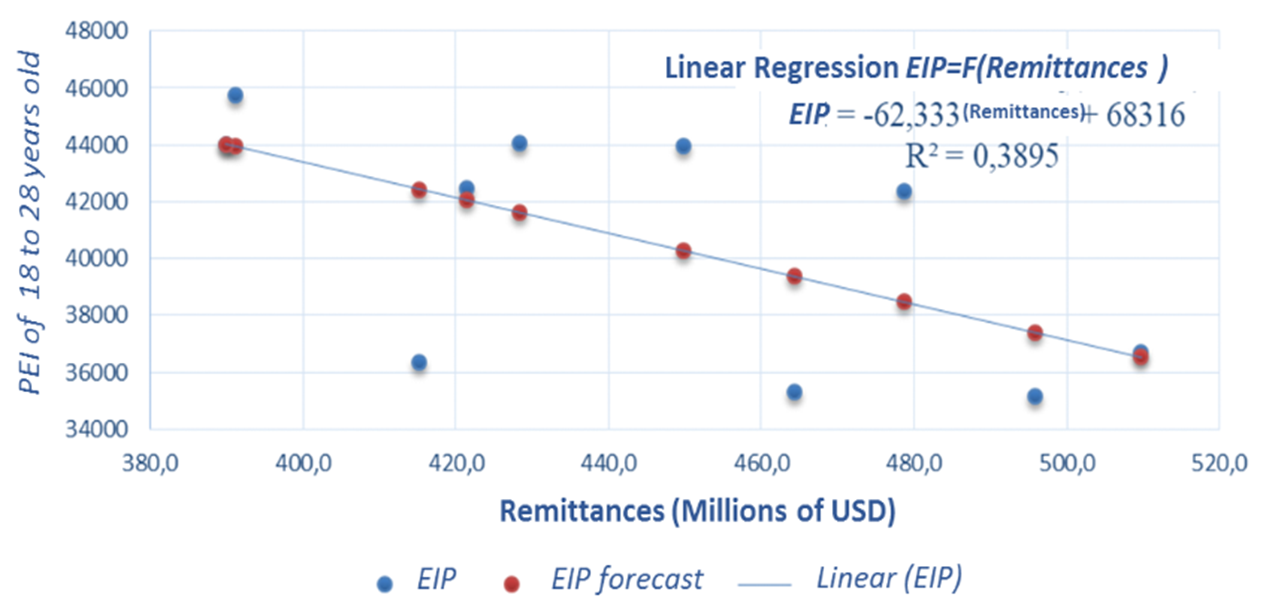
Source: Produced by the authors with Banco de la Republica’s y FILCO figures (2019)
Unlike the first two models with unitary elasticity, both variations in GPR as in Youth’s EIP attenuate the effect of changes caused by remittances in the department (see figure 10). Thus, in the face of an increase in remittances by 1% the GPR of young people would increase by only about 0,16%, ceteris paribus, while that it is reducing the EIP of young people in Risaralda by 0,68%. This atypical behavior could be explained by the migration of economically inactive young people, especially to regions of the world such as North America or Europe from which they send remittances to the department increasing the participation of young people occupied and unemployed in the Population in Age of Work (PAW) of young people during 2010 to 2018 in Risaralda.
Based on the criterion of maximizing R2 to ensure the highest possible predictive success, given a coefficient of determination (R2=0,4293) in the logarithmic model slightly higher than the linear determination coefficient (R2=0,4195), as well as exponential (R2=0,3784) it is viable to define a slight preference for the adjustment of the logarithmic model according to that criterion. Although no regression line fits the data well enough to make an adequate forecast due to only 42% of the variations in the Unemployment Rate (UR) around its mean (regression line) can be attributed to changes in the explanatory variable actual salary, the other 58% is due random forces omitted by the supra-quoted models (Gujarati & Porter, 2009).
Figure 11
Relationship between Unemployment Rate and Rate Youth Salary
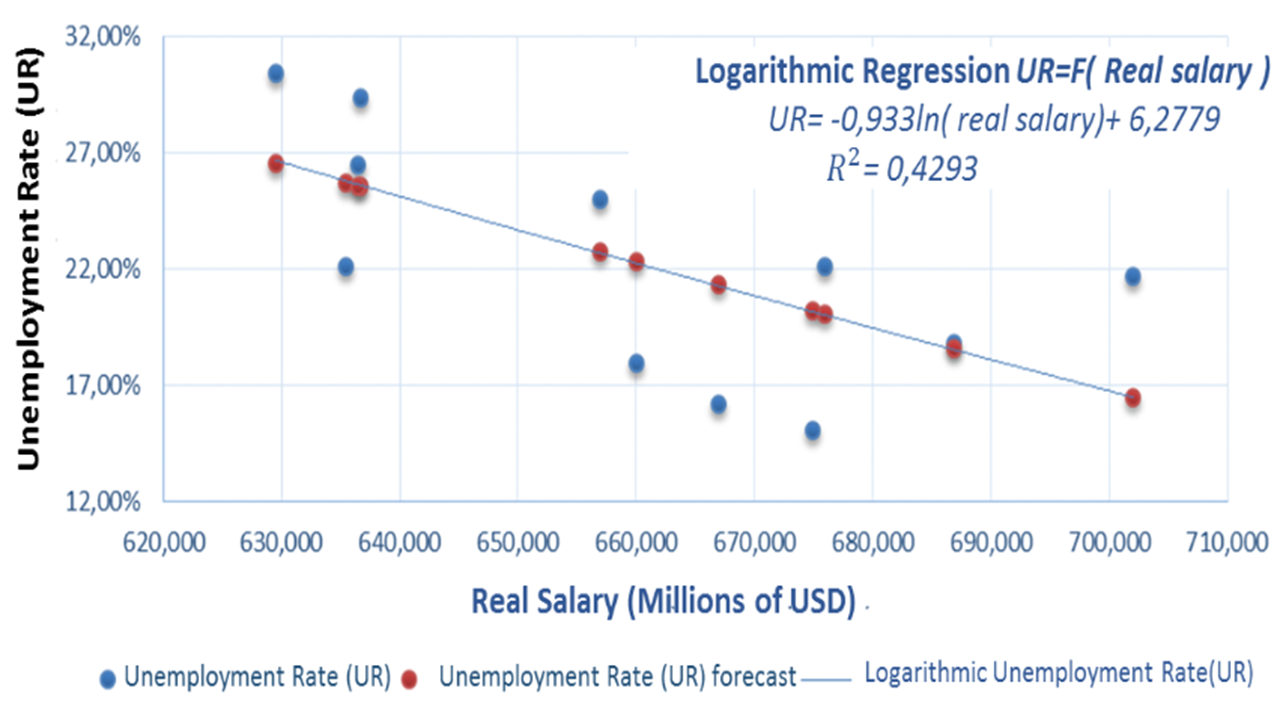
Source: Produced by the authors with World Bank’s y FILCO figures (2019)
As it can be seen in figure 11, with a R2=0,4293 it is possible to choose the logarithmic regression of the level-log form (the decreasing trend) as the most appropriate to estimate the relationship between UR and real salary of youth in Risaralda indicating that the UR will always decrease 0,933 percentage points (p.p) for every additional 1% in the amount of the real salary perceived by the young people of the MACW are showing a decreasing trend where the change of the UR for 1% of real salary in additional weights decreases as the real salary increases; in other words, logarithmic regression: UR=6,2779-0,933ln(real salary) implies a decreasing performance of the real salary on the youth's UR in the MACW (Wooldridge, 2010, page. 43).
Otherwise, in logarithmic regression; UR=6,2779-0,933ln(real salary) the value of the intercept does not have much meaning, because it denotes the UR predicted when the long (real salary) =0. Similarly, R2=0,4293 indicates that the log (real salary), more not the real salary in itself, there achieves to explain close to 42,93% of the changes in the UR (Wooldridge, 2010, page. 44).
Considering an inverse relationship between Youth’s UR and real salary at MACW, neoclassical theory of offer and demand are not adequate to explain youth’s labor dynamics by assuming that employment only occurs when wages are artificially placed above balance as when there are rigidities in the style of minimum wage (Exogenous, affected by trading variables other than UR) suggesting a positive and non-negative slope curve between UR and real youth wages at MACW6 (Velásquez M., 2017).
The genesis of such paradoxical behavior could be found in the distortions generated in the youth labour market by an exceptionally high Youth’s Informality Rate (YIR) close to 57.74% 2010 and 2018 in the MACW. Thus, in the face of an increase in the real salary of youth, the numbers of formal employed decreases when informal workers who achieve to compensate and even replace them exceed the previous Occupation Rate (labor demand); as a result, the Unemployment Rate (UR) falls instead of increasing when the real salary of youth rises in the MACW.
The Figure 12 illustrates this argument by presenting a direct relationship between YIR and real youth salary between 2010 and 2018 where it has been chosen the logarithmic regression of the log-level from (decreasing trend) as the most appropriate to estimate such association in the MACW giving a coefficient of determination (R2=0,669) slightly higher than the observed in both in the linear model (R2=0,662) as exponential (R2=0,625), although no regression line fits the data well enough to make an adequate forecast since only 66% of the variations in the YIR around its mean (regression line) can be attributed to changes in the explanatory variable real salary, the other 33% is due to random forces omitted by the mentioned models (Gujarati & Porter, 2009).
Figure 12
Relationship between Informality Rate and Real Youth Salary
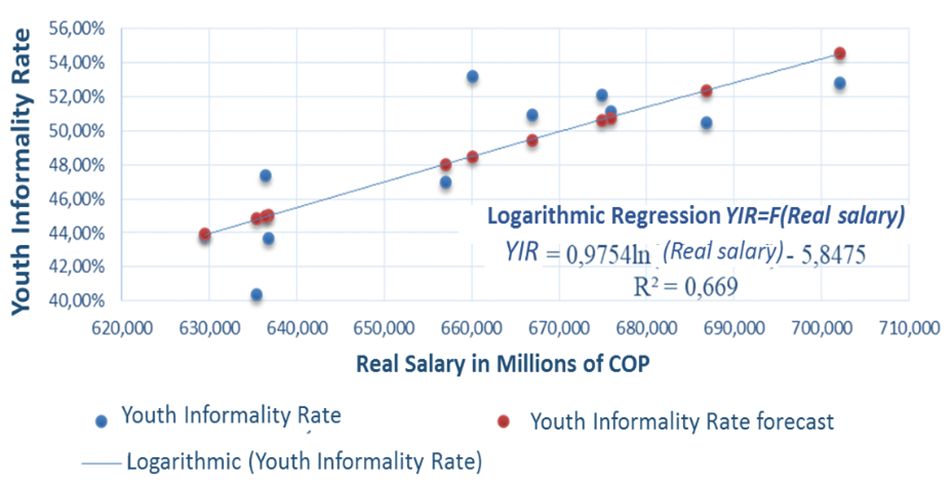
Source: Produced by the authors with FILCO’s figures (2019)
The formulation observed in Figure 12 indicates that YIR will generally increase by 0,9754 percentage points (p.p) for every additional 1% in the amount of real salary received by MACW youth showing a declining trend where the change of YIR by 1% of real wages in additional pesos decreases as the real wage increases; in other words logarithmic regression: TIJ=-5,8475+0,9754ln(real salary) implies a declining performance of the real salary over the YIR in the MACW (Wooldridge, 2010, page. 43).
Similarly, variations in youth’s UR and YIR from changes in the real wage rate of youth became more than proportional between 2010 and 2018 in the MACW. Therefore, when the real wage increases by 1 percent the UR among youth fell 4,12% while the YIR increases 2% according to the estimated elastic magnitudes for the youth labour market in the MACW.
From a completely different perspective, the inverse relationship between UR and youth real salary at the MACW could be explained by the existence of a “Wage Curve” based on the theory of efficiency wages where increases in pay to work tend to increase productivity, resulting in lower youth UR from 2008 to 2018 at MACW (Akerlof & Yellen, 1990).
In other words, the wage curve observed in the youth labour market at MACW associates a lower youth’s UR with a higher real wage (called efficiency wage) that firms are willing to pay to increase their workers efforts by reducing the moral risk of laziness at work (Akerlof & Yellen, 1990); so the higher the wage, the higher the opportunity cost assumed by a young worker if he becomes unemployed for defaulting on the productivity goals agreed with the company, which is reflected in a lower youth’s UR in the MACW.
Thus, an increase in youth GPR is often a result of an increase in UR by deterring busy young people from seeking a new job with a better real wage before a lower likelihood of joining another company (Blanchflower & Oswald, 1995), which allows these to reduce their labor costs by offering a lower real wage to 18 to 28 year-olds that implies an inverse relationship between GPR (labor supply) and real wages of youth between 2008 and 20187.
Similarly, the direct relationship between OR (Labor demand) and real wages of the youth in the MACW could be explained as follows: an increase in youth OR reduces UR by increasing the likelihood of those young people interested in seeking a new job with better wages; which is why many firms will decide to retain their workforce by offering higher real wages (efficiency wages) to MACW youth who manage to encourage an increase in labor productivity and business profits.
The Youth Wage Curve in MACW presents a UR elasticity to the real salary of youth (9.63%) much like that seen in much of the world, despite the difference in the existing wage rigidities (Blanchflower & Oswald, 1995); thus, when youth´s UR doubles the real wage of youth it decreases by about 10% in the MACW.
It should be noted that the real salary (in logarithms) is a convex and decreasing function of the logarithm of unemployment in the MACW; that is to say, the higher the TD is the lower its effect on real wages and therefore, its real salary elasticity to juvenile TD (Blanchflower & Oswald, 1995). This means an inverse relationship between TD and inflation in the short term as established in the Phillips curve8 (Phillips, 1958), so lowering a high TD (whose real salary elasticity to youth TD is higher) is less expensive in inflationary terms that decrease a high TD (with a TD elasticity at the lowest salary) (Castro Lugo, 2005).
There is a growing trend in the general level of wages of both recent graduates and male and female employees between 2006/2007 and 2015/2016. However, the average remuneration received by newly graduated women of higher education in their First Employment is 16% lower than that of men on average during that period, obtaining $1.667.255 COP against a salary of $1.936.103 COP men (see figure 13). Also evidencing the situation of inequality that arises in regard to the gender based working conditions, and which are subject to formulation within the programs and plans for strengthening First Employment.
Figure 13
Average monthly income recent higher education and salaried

. Source: Produced by the authors with basis to the Men’s Labour Observatory for Education, and the ILO (2019).
The rate of formalization of employment registered by young graduated people in their First Employment is exceptionally high. Thus, 64,6% of newly graduated young women as technicians managed to be linked to formal employment during the following year on average between 2006 and 2016; Women technologists presented a formal linkage rate of 7,9 percentage points higher (72,5%) compared to the techniques on average in their First Employment; the formality rate of professional women (79,6%) in turn, is 7,2 percentage points higher than that of technologists; but it is the women with specialization or masters who showed the highest rates of employment (92,6%) 13 percentage points higher than the professionals.
Regarding to the income, the training in doctorates during the period 2006/2016 stands out, being the best paid training and with higher levels of participation for years, followed by the master’s degrees and finally the specializations. In the case of men and women, the relationship between incomes received by recent graduates is directly proportional to the level of study acquired. Doctorate and master`s degree are the levels with the highest salary scope, and a progressive increase of the men who reach those levels between 2006 and 2016 are reflected.
In the department of Risaralda, the number of graduates has multiplied by 4, from 2.237 in 2008 to 8.714 in 2015, while the number of contributors has only multiplied by 3 in the same period, increasing from 2.289 in 2008 to 6.760 in 2015, evidencing a dynamic of labour mobility abroad (emigration) of recent graduates in Risaralda who are increasingly employed in other departments of the country.
On the other hand, Figure 14 shows a distant relationship between the total number of people graduated and total contributors between 2008 and 2016, the above related to the average salary of recent graduates of the department of Risaralda
Figure 14
Graduates, contributors to SGSS and average salary just graduates in Risaralda
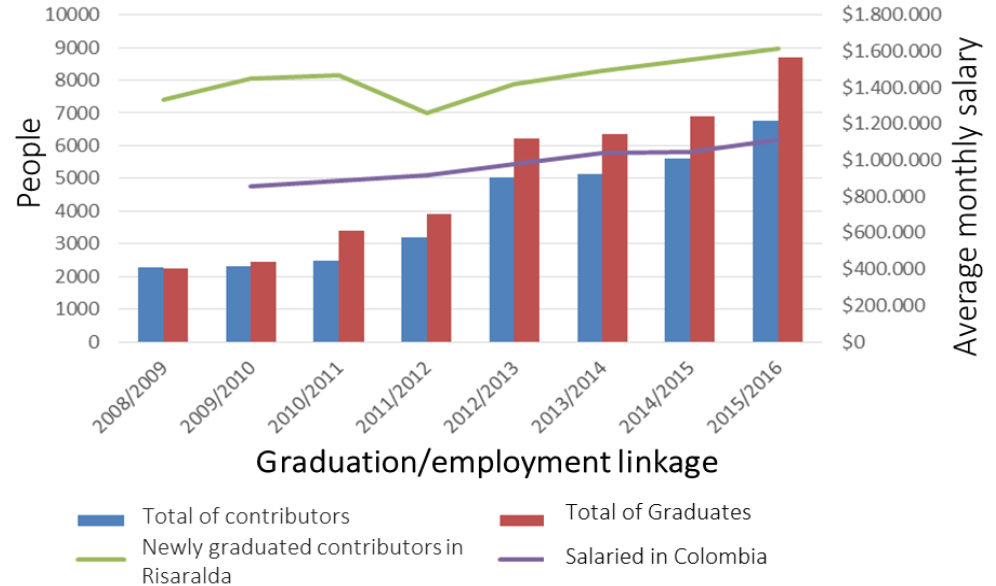
Source: Produced by the authors with basis to the Men’s Labour Observatory for Education, and the ILO (2019)9
Figure 15
Labor mobility newly graduated in Risaralda
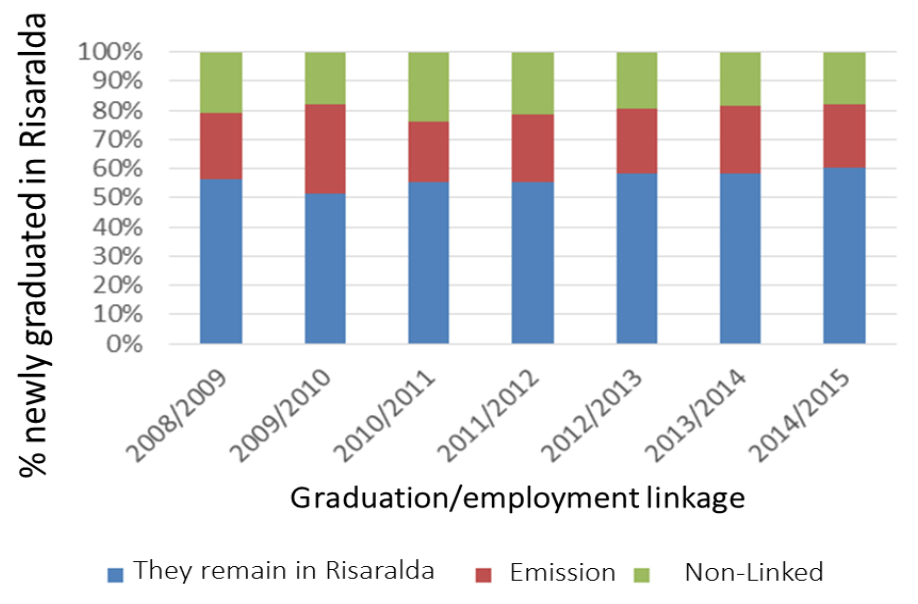
Source: Produced by the authors with basis to the Men’s Labour Observatory for Education (2019)10.
According to figure 15, 56.37% of graduates in Risaralda (approximately 22.956 young people from 2008 to 2015) managed to find their First Job in the department, 9.231 graduates representing 23.34% of the total decided to migrate to other departments of the country like Valle del Cauca, Quindío, Caldas and even Bogotá D.C. in search of their First Employment, at the same time that about 7.977 young graduates of tertiary education (20.29% of the total between 2008 to 2015) failed to work in the country, either because they emigrated abroad, or decided exit the labor market as economically inactive youth in the department.
The key to ensure a decent job perspective for young people in the AMCO is education; therefore, it is essential to encourage the completion of the different study programs through appropriate labor policies that facilitate the transition to a First Job that manages to offset the cost as an underlying opportunity to study prior to the job search (Cardona, 2016). Especially aiming at male students who according to the ILO (2017) have a graduation rate (in university studies) of 10 points more under the observed for female students.
Similarly, a higher level of training offers improvements not only in productivity, but also in the quality of life of young workers who access their First Employment that increases the power of labor negotiation and could even reduce the structural unemployment of long-term youth in the MACW (Pereira Chamber of Commerce, 2018)
On the other hand, the lack of work experience and the skills required by employers in the MACW allows the clarification on the structural factors that can explain why economic growth in many cases has not completely translated into a higher employment and lower unemployment rates after the international financial crisis at MCO (DANE, 2018). Specifically, it is observed that there is an educational mismatch in several of the sectors, Including the most dynamic; the predominance of workers employed in unstable and unsatisfactory jobs based on the results of the School to Work Transition Survey, which indicates that there are inefficiencies in the labor institutions that must improve for the proper functioning of the productive apparatus being necessary to invest in public inputs as capital human and physical that strengthen the potential capacity of the economy to generate enough decent jobs, while generating the necessary tax incentives to allocate remittances to finance ventures capable of creating new sources of work. (Cardona, 2016)
Therefore, if the imbalances that exist in the youth labor market can be corrected by strengthening the coverage and relevance of the First Employment policies applied since 2015 in the MACW (Pereira Chamber of Commerce, 2018) with policies training of human capital, adjusted to the needs of the region, undoubtedly, it could have a positive effect not only on production, but also on the quality of employment and well- being of young workers, resulting in better job opportunities, less vulnerability to exogenous shocks to the economy and lower levels of youth unemployment in the MACW (ECLAC & ILO, 2017)
How can be achieved improvements in the transition of young people to the labor market in an effective and expeditious manner under appropriate conditions of formality and accompaniment of the state?
Ahh, J., An, Z., Bluedorn, J., Ciminelli, G., Kóczán, Z., Malacrino, D., . . . Neidlinger, P. (2019). Work In Progress : Improving Youth Labor Market Outcomes in Emerging Market and Developing Economies. International Monetary Fund- IMF, Department of Investigation. Washington D.C.: International Monetary Fund- IMF. Retrieved from https://www.imf.org/en/Publications/Staff-Discussion-Notes/Issues/2019/01/18/Work-In-Progress-Improving-Youth-Labor-Market-Outcomes-in-Emerging-Market-and-Developing-45130
Akerlof , G. A., & Yellen, J. L. (1990). The Fair Wage-Effort Hypothesis and Unemployment. Quarterly Journal of Economics(105), 255-283. Retrieved from https://www.jstor.org/stable/2937787?seq=1
Atehortúa, F. H. R., & Zwerg-Villegas, A. M. (2012). Metodología de la investigación: más que una receta. AD-minister, (20), 91-111.
Blachflower, D. G., & Oswald, A. (1995). An Introduction to the Wage Curve. Journal of Economic Perspectives, 9(3), 153-167. Retrieved from https://www.jstor.org/stable/2138431?seq=1
Braynen-Kimani, N. &. (2017). In Their Own Words: Millennials reflect on the key challenges facing their generation. FINANCE & DEVELOPMENT, 24-27.
Cámara de Comercio de Pereira. (2018). Transformaciones en el Mercado laboral de Pereira entre 2010 y 2018. Cámara de Comercio de Pereira, Centro de Estudios e Investigaciones Socioeconómicas. Pereira, Risaralda: Cámara de Comercio de Pereira. Retrieved from https://s3.pagegear.co/3/investigaciones/estudios/1/estudio_01_cambios_en_mercado_laboral_de_pereira_2010_2018.pdf
Cardona, J. (2016). Una mirada al mercado laboral del departamento de Risaralda mediante las variables: Ocupación, desocupación, inactividad y población en edad de trabajar, período 2001-2014. Universidad Libre, Centro de Investigaciones FCEAC. Pereira, Risaralda: Universidad Libre seccional Pereira. Retrieved from http://repositorio.unilibrepereira.edu.co:8080/pereira/handle/123456789/777
Castro Lugo, D. (2005). Salarios y desigualdad territorial en las áreas urbanas de México, 1992-2002. Universidad de Barcelona, Departamento de Economía Aplicada. Barcelona, España: Universidad de Barcelona. Retrieved from https://www.tesisenred.net/handle/10803/4004#page=1
CEPAL/OIT. (2017). Coyuntura Laboral en América Latina y el Caribe: La transición de los jóvenes de la escuela al mercado laboral. Santiago: Publicación de las Naciones Unidas.
DANE. (2018). Mercado Laboral de la Juventud. Gorvenment of Colombia, Departamento Administrativo Nacional de Estadística -DANE. Bogotá D.C.: DANE. Retrieved from https://www.dane.gov.co/files/investigaciones/boletines/ech/juventud/Bol_eje_juventud_abr18_jun18.pdf
Dettling, L., & W. Hsu, J. (june de 2017). Recuperando el terreno perdido. Finance & Development, 20 - 21. Obtenido de https://www.imf.org/external/pubs/ft/fandd/spa/2017/06/pdf/dettling.pdf
ECLAC & ILO. (2017). The transition of young people from school to the labour market . ECLAC & ILO, Economic Commission for Latin American and the Caribbean and the office for southern cone of Latin America of the ILO. Santiago de Chile: United Nations . Retrieved from https://www.cepal.org/en/publications/42251-employment-situation-latin-america-and-caribbean-transition-young-people-school
Gobierno de Colombia. (2018). Plan Nacional de Desarrollo 2018 - 2022: Pacto por Colombia, pacto por la equidad. Gobierno de Colombia, Departamento Nacional de Planeación -DNP. Bogotá D.C.: Departamento Nacional de Planeación. Retrieved from https://colaboracion.dnp.gov.co/CDT/Prensa/BasesPND2018-2022n.pdf
Gujarati, D., & Porter, D. (2009). Coeficiente multiple de determinación R^2. In D. Gujarati, & D. Porter, Econometría (5 ed., p. 946). Washingtón D.C.: Prentice Hall. Retrieved from https://scalleruizunp.files.wordpress.com/2015/04/econometria_-_damodar_n-_gujarati.pdf
Mankiw, N. G. (1997). Phillips Curve. In N. G. Mankiw, Principles of Economics (p. 786). United States: Cengage Learning. Retrieved from http://www.jaimedv.com/eco/1c1-micro/mankiw-principios-eco-ed6.pdf
Ministerio de Educación. (2019). Observatorio Laboral para la Educación. Retrieved from http://bi.mineducacion.gov.co:8380/eportal/web/men-observatorio-laboral/vinculacion-laboral
Modigliani, F. (1988). El ciclo vital, el ahorro individual y la riqueza de las naciones. Madrid: Papeles de Economía Española. Retrieved from https://www.academia.edu/12405714/CICLO_DE_VIDA_AHORRO_INDIVIDUAL_Y_LA_RIQUEZA_DE_LAS_NACIONES
Phillips, A.W. (1958), The Relation Between Unemployment and the Rate of Change of Money Wage Rates in the United Kingdom, 1861–19571. Economica, 25: 283-299. doi:10.1111/j.1468-0335.1958.tb00003.x
Ramos, Raul & Duque, Juan & Suriñach, Jordi. (2010). Is the wage curve formal or informal? Evidence for Colombia. Economics Letters. 109. 63-65. 10.1016/j.econlet.2010.08.004.
Velásquez Pinto , M. (2017). Salario mínimo y empleo; evidencia empírica y relevancia para América Latina. Organización Internacional del Trabajo -OIT, Servicio de Mercados Laborales Inclusivos, Relaciones Laborales y Condiciones de Trabajo. Ginebra, Suiza: Publicación de las Naciones Unidas. Retrieved from https://www.ilo.org/wcmsp5/groups/public/---ed_protect/---protrav/---travail/documents/publication/wcms_600492.pdf
Wooldridge, J. (2010). Introducción a la Econometría: Un enfoque moderno (Cuarta ed.). Michigan : Cengage Learning. Retrieved from https://s386bc39b85c189f2.jimcontent.com/download/version/1464323224/module/10581840398/name/Wooldridge_Introduccion-a-La-Econometria-Un-Enfoque-Moderno-4th.pdf
1. Director of Research Center, Faculty of Economic Administrative and Accounting Sciences, Universidad Libre of Colombia, Pereira. isabel.redondo@unilibre.edu.co
2. Economics graduate of the Faculty of Economic Administrative and Accounting Sciences, Universidad Libre de Colombia, Pereira. cristian-duqueg@unilibre.edu.co
3. Economics Student, Faculty of Economic Administrative and Accounting Sciences, Universidad Libre of Colombia, Pereira. juanm-castanor@unilibre.edu.co
4. Economics Student, Faculty of Economic Administrative and Accounting Sciences, Universidad Libre of Colombia, Pereira. karen-riosr@unilibre.edu.co
5. Economics Student, Faculty of Economic Administrative and Accounting Sciences, Universidad Libre of Colombia, Pereira. karen-riosr@unilibre.edu.co
6. Classic employment models postulate that by establishing a Current Legal Minimum Salary (CLMS) higher than the equilibrium wage the oversupply (EAP>O) generated leads to a reduction in the labour demand (Youth’s OR) to the extent that the (marginal) product of work is greater than the (marginal) cost of production (PmgL>Cmg), the magnitude of which will be conditioned by the elasticity demand for work (OR) at the real youth wage in the MACW; as well as the elasticity assigned to labour supply curves (GPR), marginal labour productivity (MpcL) and marginal cost of production (Cmg) (Velásquez M. , 2017).
7. It should be noted that in the face of oversupply (GPR>OR=UR>0%), Employers do not reduce real wages, beyond a ceratin level, by nonloger tan adverse effects on labour productivity could outweigh the eventual positive effect of lowering wages, which would increase the total cost of work (Blanchflower & Oswald, 1995). Ramos, Duque y Surinach (2009) provide evidence supporting the existence of a “Wage Curve” with elasticity of -0,7 in Colombia from 2002 to 2006 based on the Continuous Household Survey published by DANE
8. According to the reasoning intrinsic to the Phillips Curve there is an inverse relationship between unemployment and inflation, as a low level of unemployment is associated with high aggregate demand, which in turn also puts upward pressure on nominal wages and prices the whole economy (Phillips, 1958).
[Index]
revistaespacios.com

This work is under a Creative Commons Attribution-
NonCommercial 4.0 International License